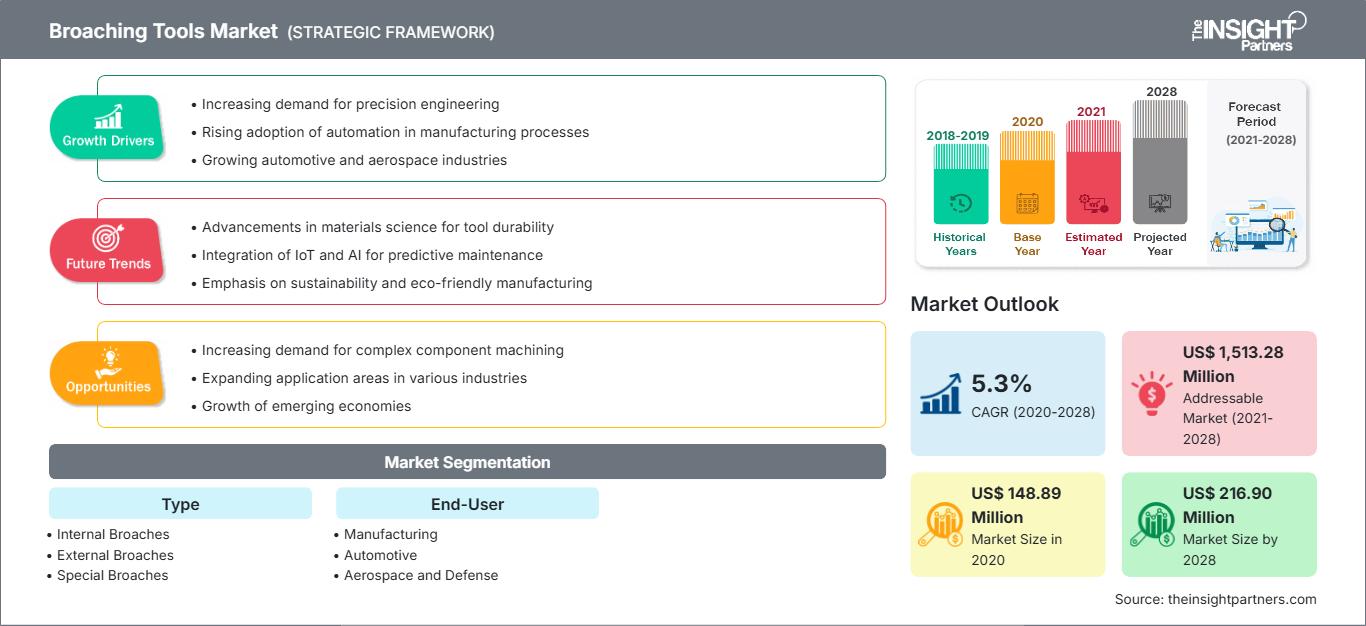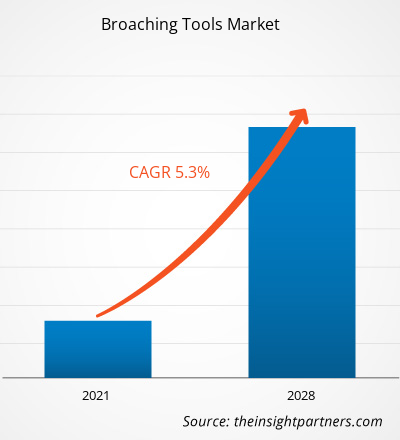Der Markt für Räumwerkzeuge wurde im Jahr 2020 auf 148,89 Millionen US-Dollar geschätzt und soll bis 2028 216,90 Millionen US-Dollar erreichen; für den Zeitraum 2021–2028 wird ein CAGR-Wachstum von 5,3 % erwartet.
Aufgrund des globalen Wirtschaftswachstums hat der Fertigungssektor in den letzten zwei Jahrzehnten erheblich an Bedeutung gewonnen, insbesondere in den Schwellenländern der Asien-Pazifik-Region. Räumwerkzeuge werden häufig zur Herstellung verschiedener Industriekomponenten und Baugruppen verwendet. Die steigende Nachfrage nach schnellen und präzisen Endbearbeitungsverfahren aus Endverbrauchssektoren wie der Automobilindustrie, der Luft- und Raumfahrt & Verteidigung sowie dem Bauwesen ermutigt Hersteller von Räumwerkzeugen, fortschrittliche Werkzeuge auf den Markt zu bringen. Der Fertigungssektor ist einer der wichtigsten Wachstumsmotoren der Wirtschaft in der Asien-Pazifik-Region. Faktoren wie niedrige Arbeitskosten, eine zunehmend junge Bevölkerung und staatliche Leistungen in Form von Tochtergesellschaften und Steueranreizen bewegen Unternehmen dazu, größere Produktionsstandorte in der Asien-Pazifik-Region zu errichten. Darüber hinaus fördern staatliche Initiativen wie „Made in China 2025“ und „Make in India“ das Wachstum des Fertigungssektors im asiatisch-pazifischen Raum. Das steigende verfügbare Einkommen der Bevölkerung führt zudem zu einem zunehmenden modernen Lebensstil in der Region, was wiederum die Nachfrage nach Unterhaltungselektronik und Automobilen ankurbelt. Dieser Faktor stärkt den Fertigungssektor. Daher treibt der wachsende Fertigungssektor das Wachstum des Marktes für Räumwerkzeuge in der Region Asien-Pazifik voran.
Passen Sie diesen Bericht Ihren Anforderungen an
Sie erhalten kostenlos Anpassungen an jedem Bericht, einschließlich Teilen dieses Berichts oder einer Analyse auf Länderebene, eines Excel-Datenpakets sowie tolle Angebote und Rabatte für Start-ups und Universitäten.
Markt für Räumwerkzeuge: Strategische Einblicke

- Holen Sie sich die wichtigsten Markttrends aus diesem Bericht.Dieses KOSTENLOSE Beispiel umfasst Datenanalysen, die von Markttrends bis hin zu Schätzungen und Prognosen reichen.
Sie erhalten kostenlos Anpassungen an jedem Bericht, einschließlich Teilen dieses Berichts oder einer Analyse auf Länderebene, eines Excel-Datenpakets sowie tolle Angebote und Rabatte für Start-ups und Universitäten.
Markt für Räumwerkzeuge: Strategische Einblicke

- Holen Sie sich die wichtigsten Markttrends aus diesem Bericht.Dieses KOSTENLOSE Beispiel umfasst Datenanalysen, die von Markttrends bis hin zu Schätzungen und Prognosen reichen.
Auswirkungen der COVID-19-Pandemie auf den Markt für Räumwerkzeuge
Der COVID-19-Ausbruch wirkt sich negativ auf die Industrie weltweit aus, und diese verheerenden Auswirkungen halten auch 2021 an. Der Ausbruch verursachte erhebliche Störungen in wichtigen Industriezweigen wie Fertigung, Gesundheitswesen, Energie und Strom, Elektronik und Halbleiter, Luft- und Raumfahrt und Verteidigung sowie Bauwesen. Ein deutlicher Rückgang der Aktivitäten in den genannten Branchen wirkt sich negativ auf die Entwicklung des Marktes für Räumwerkzeuge aus. Die erneute Einführung von Eindämmungsmaßnahmen wie Reisebeschränkungen, Handelsverboten und Personalbeschränkungen an Arbeitsplätzen hat die Herstellung, die Versorgung und den Verkauf verschiedener Unternehmen gestört, darunter auch von Industrieausrüstung wie Räumwerkzeugen.
Markteinblicke für Räumwerkzeuge
Steigende Automobilproduktion
In den letzten Jahren ist die Nachfrage nach hochwertigen Automobilen gestiegen, was zu einer erhöhten Fahrzeugproduktion geführt hat, hauptsächlich in den entwickelten Regionen wie Nordamerika und Europa. Darüber hinaus steigt die Nachfrage nach Nutzfahrzeugen und Personenkraftwagen, vor allem in Entwicklungsländern. Räumwerkzeuge werden im Automobilsektor häufig zur Herstellung von Zahnrädern, Getriebewellen, Lenkradnaben, Lenkgabeln und mehr verwendet. Laut dem Center for Automotive Research, einer gemeinnützigen Organisation, investierten Autohersteller wie FCA, GM, Ford, Hyundai, Nissan, Volkswagen und Toyota im Jahr 2018 4,8 Milliarden US-Dollar in die Automobilindustrie. Darüber hinaus sind die Investitionen in Forschung und Entwicklung (F&E) in der Automobilindustrie in Europa um 6,7 % auf 67,09 Milliarden US-Dollar pro Jahr gestiegen. Die steigende Nachfrage nach Fahrzeugen der Oberklasse und die zunehmende Fahrzeugproduktion fördern somit den Einsatz von Räumwerkzeugen in der Automobilindustrie.
Typbasierte Markteinblicke
Basierend auf dem Typ ist der Markt für Räumwerkzeuge in Innenräumwerkzeuge, Außenräumwerkzeuge und Spezialräumwerkzeuge unterteilt. Das Segment Innenräumwerkzeuge hatte 2020 den größten Anteil. Aufgrund der steigenden Nachfrage nach vertikalen Räummaschinen wird für den Markt für Innenräumwerkzeuge im Prognosezeitraum ein schnelleres Wachstum erwartet. Die Innenräumtechnik wird häufig zur Herstellung verschiedener Präzisionskomponenten wie Automobil- und Maschinenzahnrädern, Schusswaffenkomponenten und Befestigungselementen eingesetzt. Mit der stetigen Industrialisierung weltweit wird der Markt für Räumwerkzeuge im Prognosezeitraum voraussichtlich ein deutliches Wachstum verzeichnen.
Die Akteure auf dem Markt für Räumwerkzeuge konzentrieren sich auf Strategien wie Fusionen, Übernahmen und Marktinitiativen, um ihre Marktposition zu behaupten. Im Folgenden sind einige Entwicklungen der wichtigsten Akteure aufgeführt:
- Im Jahr 2020 brachte die Blohm Jung GmbH die PROFIMAT XT mit Werkzeugwechsler auf den Markt. Das Werkzeug ermöglicht einen automatischen Wechsel von Schleifscheiben. Diese flexible PROFIMAT XT vereint vier Schleiftechnologien in einer Maschine: Pendel-, Schleichgang-, CD- und Schnellhubschleifen.
- 2018 stellte die Blohm Jung GmbH auf der IMTS ihr neues Produkt namens PROFIMAT XT als Weltpremiere vor. Diese Markteinführung ist eine Erweiterung des Schleifmaschinenportfolios.
Markt für Räumwerkzeuge
Die Analysten von The Insight Partners haben die regionalen Trends und Faktoren, die den Markt für Räumwerkzeuge im Prognosezeitraum beeinflussen, ausführlich erläutert. In diesem Abschnitt werden auch die Marktsegmente und die geografische Lage in Nordamerika, Europa, dem asiatisch-pazifischen Raum, dem Nahen Osten und Afrika sowie Süd- und Mittelamerika erörtert.Umfang des Marktberichts zu Räumwerkzeugen
| Berichtsattribut | Einzelheiten |
|---|---|
| Marktgröße in 2020 | US$ 148.89 Million |
| Marktgröße nach 2028 | US$ 216.90 Million |
| Globale CAGR (2020 - 2028) | 5.3% |
| Historische Daten | 2018-2019 |
| Prognosezeitraum | 2021-2028 |
| Abgedeckte Segmente |
By Typ
|
| Abgedeckte Regionen und Länder | Nordamerika
|
| Marktführer und wichtige Unternehmensprofile |
|
Dichte der Marktteilnehmer für Räumwerkzeuge: Verständnis ihrer Auswirkungen auf die Geschäftsdynamik
Der Markt für Räumwerkzeuge wächst rasant. Die steigende Nachfrage der Endverbraucher ist auf Faktoren wie veränderte Verbraucherpräferenzen, technologische Fortschritte und ein stärkeres Bewusstsein für die Produktvorteile zurückzuführen. Mit der steigenden Nachfrage erweitern Unternehmen ihr Angebot, entwickeln Innovationen, um den Bedürfnissen der Verbraucher gerecht zu werden, und nutzen neue Trends, was das Marktwachstum weiter ankurbelt.

- Holen Sie sich die Markt für Räumwerkzeuge Übersicht der wichtigsten Akteure
Der globale Markt für Räumwerkzeuge ist wie folgt segmentiert:
Markt für Räumwerkzeuge – nach Typ
- Innenräumnadeln
- Außenräumnadeln
- Spezialräumnadeln
Markt für Räumwerkzeuge – nach Endverbraucher
- Fertigung
- Automobilindustrie
- Luft- und Raumfahrt & Verteidigung
- Bauwesen
- Sonstige
Markt für Räumwerkzeuge – nach Geographie
Nordamerika
- USA
- Kanada
- Mexiko
Europa
- Frankreich
- Deutschland
- Italien
- Russland
- Vereinigtes Königreich
- Rest von Europa
Asien-Pazifik (APAC)
- China
- Indien
- Japan
- Australien
- Südkorea
- Rest von APAC
Naher Osten und Afrika (MEA)
- Saudi-Arabien
- VAE
- Süd Afrika
- Rest von MEA
Südamerika (SAM)
- Brasilien
- Argentinien
- Rest von SCAM
Firmenprofile
- American Broach & Machine Company
- Arthur Klink GmbH
- Colonial Tool Group Inc.
- Ekin S coop
- Blohm Jung GmbH
- Messer Raumtechnik GmbH & Co. KG
- Mitsubishi Heavy Industries Machine Tool Co., Ltd.
- Nachi-Fujikoshi Corp.
- The Broach Masters, Inc.
- Miller Broach
- Historische Analyse (2 Jahre), Basisjahr, Prognose (7 Jahre) mit CAGR
- PEST- und SWOT-Analyse
- Marktgröße Wert/Volumen – Global, Regional, Land
- Branchen- und Wettbewerbslandschaft
- Excel-Datensatz
Aktuelle Berichte
Erfahrungsberichte
Grund zum Kauf
- Fundierte Entscheidungsfindung
- Marktdynamik verstehen
- Wettbewerbsanalyse
- Kundeneinblicke
- Marktprognosen
- Risikominimierung
- Strategische Planung
- Investitionsbegründung
- Identifizierung neuer Märkte
- Verbesserung von Marketingstrategien
- Steigerung der Betriebseffizienz
- Anpassung an regulatorische Trends




















 Kostenlose Probe anfordern für - Markt für Räumwerkzeuge
Kostenlose Probe anfordern für - Markt für Räumwerkzeuge